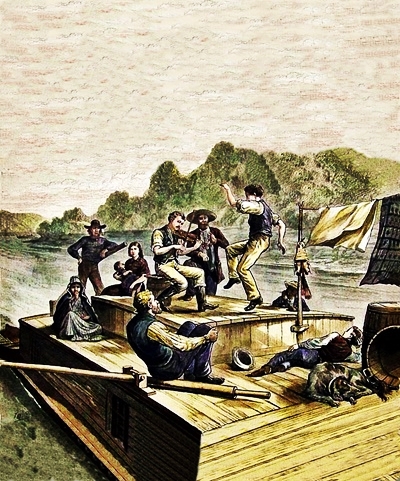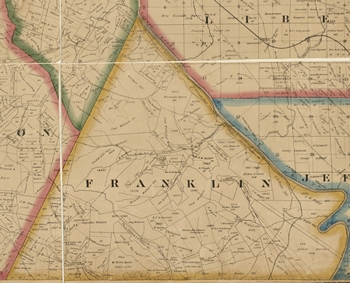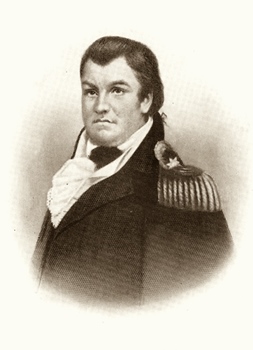| John Bushong and Jenette Young Part Two: Ohio Pioneers
|















|
|
The Frontiersman and the Lady
John Bushong
and
Jenette Young
Part Two
By Rick Bushong
September 10, 2015
|
John likely rode a barge or keel boat, on the Kentucky River, and maybe others to enter Ohio. With liberties from an Illustration by Frank Leslie, (Barging to Louisville).
|
An Acknowledgement
I would like to acknowledge and thank Judy Cassiday for the invaluable work, that was done on the Ohio, Kentucky and early Virginia Bushongs, then shared in the Bushong Bulletin.
The Spring of 1987 issue and also others are filled with her research. Judy's professionalism and her "get it all" attitude helped immensely to flesh out these and other Bushong Ancestors.
The First Bushongs in Ohio |
|
Ohio, the home of the most Bushong families anywhere in America.
|
|
It was in the spring of 1797, at the age of 36, that John Bushong left his Kentucky home, wife, and family and trekked off to the north east. The pioneer inevitably traveled overland and by river and ended up some 160 miles away, deep in the Northwest Territory, making him the first Bushong in the territory.1; 2 Where John stopped was in an area, that was freshly surveyed and organized. It was destined to become his new home as well as the state of Ohio. Here, he would create a rich and complex civic record, becoming involved in numerous land transactions and other events. Through these it is possible to gain a better understanding of his life in Ohio.
John is first documented, May 2, 1797, in the fledgling village of Chillicothe, in Adams County (became Ross County August 20, 1798). At the time, he and a James Scott, issued a bond, and were bound to one David Powell (for $148.38 to be paid before November 1, 17971). Mr Scott, was an early resident of the village and an accomplished lawyer, who served various official posts.3 It can not be certain, but seems likely, the deal between John and Mr. Scott and David Powell, was simply Mr. Scott co-signing for John, in return for some service, The note indicates payments were made and the debt was apparently paid off. Further, it is seems likely that this deal is the beginning of John's keel boating days, and represents the purchase of a keel boat. Because a year and a half later, we find the price of a keel boat established at $160, from the sale of a keel boat, perhaps the same one, that John attempted to sell, (discussed below). The difference of $11.62 could easily be a down payment. John would have hauled cargo to pay off the note as well as his obligation to Mr. Scott.
|
Two months after buying the keel boat, July 1, 1797, John purchased property, Lot 15, in Chillicothe.4 Soon he would have been building a cabin or house, and preparing to move his family. In July, when the deed was written, Jenette was not listed, so she was still back in Kentucky. This is true, also because on October 16, 1797, their last child, John (Jr.) was born in Kentucky, or at least he always stated he had been born, in Kentucky.5 As busy as John was, it is likely that Jenette had their last child, while John was up in Ohio. Regardless, it is hard to say exactly when the full family moved, but apparently it was after John Junior's birth. Johns mother, Catherine was living in Chillicothe before June 30, 1798, when she purchased her lot in Chillicothe, Lot 71 and she inevitably arrived before then.5 This places the Bushong family's Ohio migration between the fall of 1797 and the spring of 1798. Remember, John's note, for the keel boat, was due November 1, 1797. He would have been working trying to get it paid off. Then John's brother, Valentine is found as early as February 1, 1798, in Chillicothe. That is when he signed a Scioto River Valley petition (for cheaper land), but to have become aware of the petition, he would have entered Ohio before that date.6 Three weeks later, John has Lot 15 recorded February 21, 1798.7 If John had waited too long, to move his family from Kentucky, the various primitive trails, leading to Ohio, would have become worse. They would inevitably be frozen and treacherous in the winter, and in the spring would become mud. Also the thaw, would make fording the swollen rivers more difficult. With such a young infant, traveling would be dangerous and slow. With this in mind, it is an inevitable conclusion that John and his family migrated in the keel boat. A study of the rivers shows that from their acreage on Big Benson Creek, Kentucky, it was possible to travel by river all the way, to Chillicothe. It might have taken several weeks or more, to travel the different rivers, especially if it was in the winter. But on a keel boat there would be some protection from the elements and warmth from a fire or a stove.
Big Benson (Benson Creek) empties into the Kentucky River, at Frankfort. The Kentucky River flows generally north west and joins the Ohio River at Carrollton. The Ohio River flows generally west and southward, and the Scioto River, flows southward and joins the Ohio at Portsmouth, Ohio.8
Though the children would have been too little to help pole the boat, when they were on the Ohio and Scioto Rivers, they surely would have remembered such a trip for the rest of their lives.
But the whole family had not followed John to Ohio, and it ultimately split up the brothers. Coming along with John and Jenette, and their five children, were his mother Catherine, now around 60 years old, and his younger brother, Valentine. But three brothers stayed behind, Jacob, George, and Henry, in addition, there was his older brother, Andrew (Jr.), who had never left Virginia. However, it is from the purchase of Lot 15, that John is recognized by the First Families of Ohio Society.9 In October 1799 John sued one Wm. Craig over a deal with a keel boat. He had sold a keel boat to Craig, who was supposed to pay off the debt by hauling eight tons of cargo from, the mouth of the Scioto River to the village of Chillicothe. When delivered it would net John, one dollar per one hundred pounds, or $160.10 The issue must have been resolved because August 9 1800 John Bushong again has dealings with Craig, when they became partners on Lot 160 in Chillicothe, purchased for $30.50.10
|
|
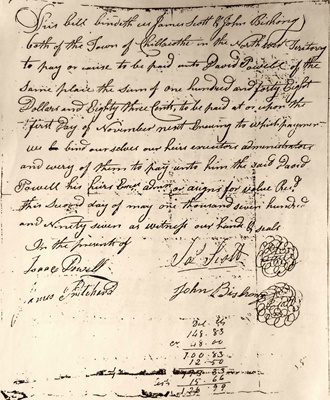
John Bushong's bond in Chillicothe, Ohio May 2, 1797. This probably represents when John bought his first keel boat.
|

A keel boat travels the river.
|
|
Chillicothe and Keel Boating on the Scioto River
Rivers had always played a major part of John's and his father, Andrew's life. Their waters were necessary for everything that was grown on the homesteads as well as commerce. Andrew lived on rivers virtually his entire life, in America. John did too, on Cub Run, Big Benson, and ultimately, for 28 years or so, the Scioto River. The Scioto River flowed southward through Chillicothe, all the way until it entered the Ohio River at the City of Portsmouth. John Bushong was noted with a keel boat October 1799, and as discussed, it was probably 1797, when he entered the keel boat business.11 Their property in Chillicothe was too small (99' x 198') for farming, John would have needed some way to support his family. There is a chance, with his prime downtown location, when he was not on his boat, John became a cobbler, since he is later shown to have the tools and materials.12 Yet it seems more likely that John made a living with his keel boat.
|
|
The boatmen, calling themselves "Keelers" on keel boats and "Bargers" on the river barges, were an independent and rugged breed, including the likes of Mike Fink, who was unquestionably, the most famous of the keelers, (born between 1770 and 1780 – died about 1823).13; 14 These keelers hauled freight up and down the rivers using, when they could, the river's current, to propel their cargo filled boats, and when against the stream, any combination of poles, sail, ropes, or just grabbing the bushes on the river banks (bush-whacking) and pulling the boat along. Around the turn of the 19th century, keel boats and barges were a major part of life and the economy for much of the mid west, all the way down the Mississippi River, to New Orleans. The numerous communities lining the rivers needed food, goods and freight and on the river the keel boats could haul it. In 1810, Chillicothe was described as "a bustling, thriving town, employing no less than 60 keel boats in transferring the products of the rich valley from this “port” to the southern markets15..." The trips could take many weeks and sometime months, depending where on a river you were headed, it often taking ten times longer up stream than down. Along the way there were numerous dangers from the waterways as well as from Indians and outlaws in the settlements along a river, and areas in control of waterborne pirates. So it was a rough bunch who plied the western river ways.16; 17 Perhaps this boast attributed to Mike Fink, speaks to a little in John and every Keeler of the day...
|
|
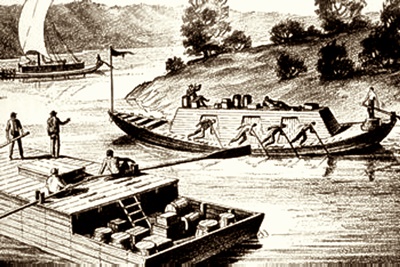
Around the turn of the century, barges and keel boats, plied the rivers, carrying products, produce, and passengers.
|
"Im a Salt River Roarer! Im a ring-tailed squealer! I'm a reg'lar screamer from the ol' Massassip'! Whoop! I'm the very infant that refused his milk before its eyes were open, and called out for a bottle of old Rye! I love the women an' I'm chockful o' fight! I'm half wild horse and half cockeyed-alligator and the rest o' me is crooked snags an' red hot snappin' turtle. I can hit like fourth-proof lightnin' an' every lick I make in the woods lets in an acre o' sunshine. I can out-run, out-jump, out-shoot, out-brag, out-drink, an' out fight, rough-an'-tumble, no holts barred, ary man on both sides the river from Pittsburg to New Orleans an' back again to St. Louiee. Come on, you flatters, you bargers, you milk-white mechanics, an' see how tough I am to chaw! I ain't had a fight for two days an' I'm spilein' for exercise. Cock-a-doodle-doo!18"
|
|
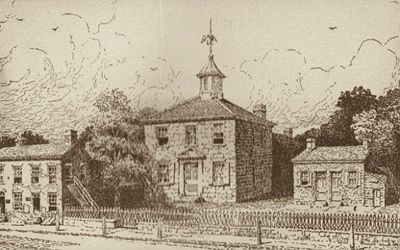
The original Court House and for a while County seat, in Chillicothe, built in 1801.
|
|
In order to make a living with his keel boat, John hauled freight. It is possible to get an idea of how much he charged, from the deal he planned with Mr. Craig in October 1799. In that deal, for hauling cargo up river, from the mouth of the Scioto at Portsmouth, to Chillicothe, he charged $1.00 per hundred pounds. He probably hauled the occasional passengers up and down the Scioto River, too. But his business would not be restricted to just the Scioto, if he chose, some trips could have taken him all the way down the Mississippi to New Orleans. When John was not sailing, he and Jenette made their home on the corner of Paint and Main Street, (lot 15). At the time he purchased the lot in 1797, John likely realized what a valuable piece of property it would become, because of its central location to the village and future city of Chillicothe. In fact, the corner of Main and Paint Streets, is on an opposite corner to the original State Capitol Building and Courts, built in 1801. As close as it was, it is understandable how shortly after 1798, when court proceedings began, John was one of the first twelve jurists, impaneled on the county's first ever jury trial, (Kennett vs. Hamilton).19 Now days his old lot is prime downtown real estate.
|
The area grew rapidly, and within a few years, March 1, 1803, Statehood was granted to Ohio. Maybe in that time, the bustle of the Village Chillicothe, became too much, or maybe John was tired of being gone for so long, hauling freight on the rivers. Besides, the river life was not an older man's occupation. When Mike Fink was killed in 1823, he was somewhere in his forties. Perhaps John also in his forties, and Jenette just wanted to get back to farming? And a few miles down the river, John had spotted some rich land that would be good for a farm. It was in the area that became the township of Franklin. So it was in 1804, seven years after moving to Chillicothe, that they sold the town property for $300, which is roughly 10 times what he paid for it.20
|
|
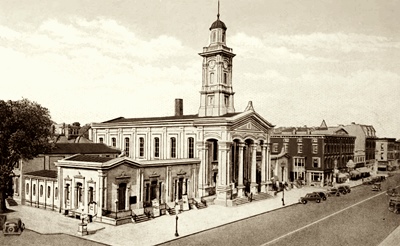
This is the Court House, that replaced the original built in 1801. John and Jenette's property was on an opposite corner.
|
The Family Moves to Franklin Township |
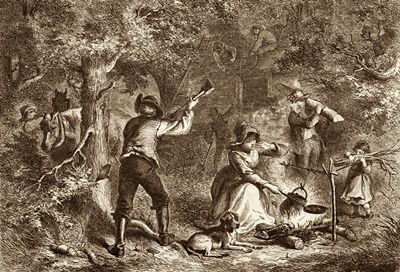
Titled border settlers in Ohio (in 1790s).
|
|
Franklin Township, like Chillicothe, is on the Scioto River, which runs about ten miles along the eastern border. The lands near the river are exceedingly rich, and said to be "unsurpassed in fertility by any other in the county21". John and Jenette's acreage was along the river, and again with a keen eye for land, they had ended up with some of the richest land in Ross County. The date John and Jenette bought this property has not been located, although 1804, with the sale of their town lot, seems the likely year. Never the less, with John's history in keel boating, it is a foregone conclusion that he, Jenette, and the rest of the family moved to Franklin by river, very likely in a keel boat that he had owned and sailed.
John is directly associated with Franklin in 1809, and his land was within the township borders. Actually one part of John's property, "at the mouth of Pattons run", is noted in the original township survey, made sometime before September 9, 1806, when it officially became a township.22 Pattons or Patton's Run can not be located, and it seems likely the disruption from the construction of Ohio and Erie Canal, completed some 25 years later, changed it is course and now it is now called Stony Creek. John and Jenette would spend the rest of their lives, in Franklin, on their farm, along the Scioto River. For historical interest, from a deed dated October 8, 1824, here is a description of the portion of John's Franklin property, sold to his son in-law, Bayles Breedlove.
|
"All that tract or parcel of land lying and being in the county of Ross and State aforesaid, being part
of Scotts survey Beginning at four sycamores at the mouth of Pattons run running S 55 W 72 poles to
a sugar tree, Thence South 66 degrees 166 poles to a white oak thence 59 1/2 W 64 poles to a
white oak, thence North 11 degrees E 84 poles to a hickory, thence N65 degrees E 108 poles to a
hickory, thence S 51 degrees E 38 poles to a dogwood thence 70 degrees E 42 poles to a white oak
thence 33 degrees East 61 poles to a sugar tree, thence in a direct line to the Scioto River thence
with the meander of the river to the place of Beginning, containing by computation two hundred
and thirty and a half acres, be the same more or less.23"
(1 rod = 16.5 feet)
| |
|
For John and Jenette, on their farm in Franklin, the years passed while they both worked together building their home and the farm. The children helped too, at least until they married, and eventually the farm grew into a comfortable livelihood for them. John acquired a sawmill, and as they cleared the land, the trees were cut into lumber to build their home and any extra was sold and delivered in his wagon.12 Early on, as their land opened up, they planted an apple orchard, with trees inevitably of the cider variety, and it grew into a fine orchard. In fact, John Mitchel later swore (in a lawsuit) it was "one among the oldest and most valuable ...apple orchards in the County.23" Over the years they probably made money with their apples, but they also raised hogs and turkeys. Eventually there was close to 100 hogs, not to mention the 18 turkeys on the farm.12 Yet it seems likely John still hauled freight in his wagon. This, judging from the wagons, horses, and extensive gear, and harness, listed in his estate. Along with the regular and ongoing repairs his wagons needed, even up to his death, it seems likely. He had been hauling freight in his boat for years, continuing in his wagon would be a natural transition. And as discussed earlier, it is possible he was "freighting" in Kentucky, too. Maybe more so than tobacco farming, since tobacco farming was very labor intensive, and often relied on "slave labor." John had proven he was not interested in slavery, when he left Kentucky since in the Northwest Territory, slavery was banned from its beginning.24 it is also possible that John made money as a cobbler, yet somehow for a "Riverman" it just seems doubtful he ever did it commercially. but rather just for his family. Never the less, he had the tools and store records show purchases of shoe leather, as late as 1825.12 Though admittedly, these purchases in 1825 were probably for what was then, his "new family."
|
|
A detailed map of Franklin Township, Ross County, Ohio, created in 1860. It lists all the property owners of record and their properties, but by 1860 the Bushongs were gone. The Scioto River runs the length of the east boundary. Map is a section of a larger map of Ross County, from the Library of Congress, here
|
In an old Franklin Township "estray book" from the Higby Store there is and entry in 1809, for John Bushong. An estray book served a function similar to a Lost and Found bulletin board, with early residents reporting in Higby's Store Book, between the years of 1803 and 1839. Also listed in Higby's book for the same year, is his son, George and a Lewis Rush.25 This would be George's father in-law, since, February 18, 1809, George Bushong married Lewis' daughter, Lydia Rush.26 Two more of John and Jenette's children were married 18 months or so later, when Nancy married her first cousin, James Young (II), July 12 1810, and James married Nancy McCreary on August 31, 1810.26 The War of 1812, interrupted their lives, when Britain and the Crown, challenged America's new found autonomy, and two of John's sons, as well as two of his brothers joined the fight. His youngest son, John (Jr.) obviously volunteered, not wanting to miss the anything, joined before he turned 15. and enlisted September 14, 1812 in Captain John Foster's Mounted Company.27 George, now with three daughters, and one less than a year old, was not in such a hurry and he was drafted in 1813, into the 2nd Ohio Militia. He was a made a Sergeant, in Captain David Lyon's Company, part of Colonel John Furguson's Regiment, in the Division of General Robert Lucas.28 Their Company helped to break the siege of Fort Meigs, allowing General William Henry Harrison and his men to break out. Down in Kentucky, two of John's younger brothers, George and Henry, both served too.29
|
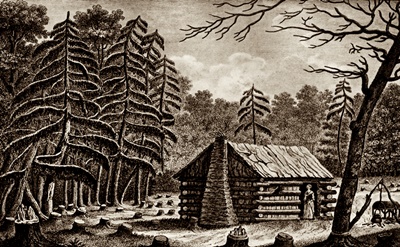
A typical pioneer cabin.
|
|
Following the war, the last of their children were married. Sarah "Sally" married John Mitchel, December 26, 1815 and finally, John (Jr.) married Eleanor Ruth Rush, also a daughter of Lewis Rush, May 12, 1816.26 With the children married-off, John and Jenette lived and worked the farm by themselves, but the family all lived in Franklin and could visit and help on the farm.30 Then sometime in 1817 it was surely a sad passing when their mother, grandmother, and great grandmother Catherine Bushong, died.31 For some 27 years following Andrew's death, Catherine would have been the grand matriarch for the family. The children and heirs sold her Lot 254, on November 18, 1817.31 The deed named the four surviving sons and their wives, "John Bushong and Janett Bushong his wife, Jacob Bushong and Jane Bushong his wife, George Bushong and Martha Bushong his wife and Henry Bushong and Issabella Bushong his wife." Sometime around Catherine's death, John's brother, Jacob, his wife Jane, and family moved from Kentucky also to Franklin Township. Jacob apparently had only planned on helping with the estate, but ended up liking Ohio and he moved up from Kentucky.30; 32 When the 1820 Census was taken, Jacob was living in the township, along with John's sons and married daughters. Of course John and Jenette were also enumerated, but were separated by many households from their children. In the 1820 Census, of Franklin, Ross County, there were 55 households or families counted. The Bushongs and Bushong daughter's households accounted for seven of them.30 Later in 1820, John visited the Courthouse in Chillicothe, across from his old property, and on Wednesday November 15, 1820, he accidentally lost his wallet...
|
Five Dollars Reward
Lost out of the subscriber's pocket yesterday morning, in the visiting of the Courthouse, a red Morocco Pocket Book, containing 25 bank bills of the state Bank of Kentucky, and many valuable papers; among which are a note of hand on William Kelly for 85 -- one on James Bushong, for 81 and some cents; one on John Bushong Junior, for 85 and some cents, with some credit on the two last notes -- also, a county order for 82; and sundry other papers of no value whatever to any one but the owner. Whoever may have found the same, and will leave it together with its contents, at this Office, or Mr. Fitch's tavern, shall receive the above reward.
John Bushong
The Scioto Gazette
Chillicothe, Ohio
Thursday 16 November 1820
Volume VI, Issue 14, Page 3
|
John's misfortune caused him to place an advertisement, which now can provide unique insight into his 1820 finances. Because by examining the contents of his "red Morocco leather pocket book", we get a glimpse of a man still involved in many pursuits. The 25 bank bills from the Bank of Kentucky, might have been worth something a year or two earlier, but after the "Panic of 1819" they had lost most of their value. Many business would not even take them, so in effect, with them, John had already lost and they were virtually valueless.33 But there were three notes, two of which were from his sons. These totaled some $251, and a court order, seemingly in John's favor for $82. Regardless, just from his wallet, it can be seen, John was owed some $333, a fair amount of money. Adjusting for inflation, the equivalent amount in today's (2015) dollars would be around $6,800.34 It is not known if John's red leather pocket book, was ever returned.
|
Living in Ross County, John was to have numerous land dealings. One person he seems to have been frequently involved with is, Duncan McArthur, a local hero and Chillicothe resident. Duncan McArthur, (1772-1839), was a noted General in the War of 1812, a U.S Congressman and later in 1830, State Governor.35; 36 From his military service he had acquired massive land holdings. In 1819 and maybe earlier, John began purchasing land from the General, in Ross and Logan counties.37 A couple of years later, in 1821, there were three more contracts between the two and their wives, with land going back and forth.38; 39 In June of 1821, John and Jenette also were involved in a Ross County land contract, for 15.2 acres to a Richard Tomlinson. Tomlinson was one of the original settlers in Franklin, and would be later involved in John's estate settlement. Interestingly, Tomlinson was sold the land for one dollar. as was one sale to the General.40
It was sometime after the last land contract, in June and before December 25, 1821, when wife and mother, and grandmother, Jenette Young-Bushong passed away. This is deduced from John's later estate records, when his daughter, Sally Bushong Mitchell, began helping and working for her father, which was about December 25, 1821.12 From this, it is appears Jenette probably died around then, so it would be safe to state the date of her death as, December 1821, in Franklin.
John, now 61 years old, was a widower. it is not known how the loss of Jenette effected him and his life, but for virtually the next 11 months, someone from the family stayed with him. As noted, his daughter Sally and her husband, John Mitchel, as well as his son George and his daughter, spent time at the farm. They helped out with chores and his daughter and granddaughter even lived on the farm for a while. In fact, Sally lived with John until August of 1822, and after that John's granddaughter, (by his son, George), Rosannah, called "Roseanny", stayed with him until Thursday in the middle of November. Because that is the day she went home, since her grandfather was getting married. It can be imagined, John had spruced himself up a bit before he put on the new shirt and waistcoat, his granddaughter had sewn for him. Then after hitching up his wagon, maybe choosing his black horse and brown mare, John headed down the rutted roads, and he was off to marry the Widow Breedlove.26
|
|
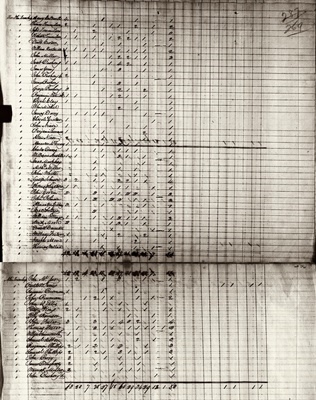
The 1820 Census for Franklin Township, Ross County, Ohio. The whole township, (both pages). John (Sr.) is at the bottom, the rest of the family is towards the top.
|
John Bushong and The Widow Breedlove
|
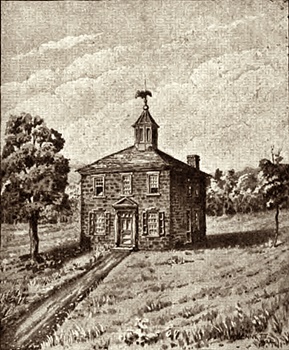
The original Chillicothe Court House, where John and Elizabeth Breedlove were probably married in 1822.
|
|
In Ross County, November 14, 1822. probably at the Court House in Chillicothe, which was close to Twin Township where his bride lived, as well as his farm, John and Elizabeth Breedlove were married.41 His new bride, according to Breedlove family genealogy, was born Mary Elizabeth Lloyd around 1772, in Virginia. She was married to her first husband, Thomas Breedlove about 1791 also in Virginia, where they eventually had eight children. Sometime before 1807, the Breedloves moved to Ohio, where their ninth and last child was born. Regrettably, Mr. Breedlove died, sometime before the 1820 Census, when Elizabeth was listed as head of household, in Twin Township, Ross County.41 This of course left Elizabeth, to raise and provide for her children, several of whom had not become old enough to go off on their own. With such a large family, it is certain the Breedloves and the Widow Breedlove were well known in the area. John being recently widowed, with his children all grown up, and being a man of property, would have indeed been, quite the eligible widower. Simply, John needed a wife to help with the farm and household, as well as to look after him. Elizabeth Breedlove, needed to provide for her children. Three had still not reached adulthood, and as she was now likely 50 years old, there was no time to spare.42 Also, a son, Bayles, (spelled Bales on his tombstone) had just turned 21, but was apparently still living at home. So on that day, when they were joined in matrimony, John also acquired a ready made family, the Breedloves.
Sadly their marriage was to last less than three years, because just 35 months later, John would be dead. But in that short time, many details of John and Elizabeth's lives have been saved in the form of bills and details from John's probate records.12 They go back, a couple of years and in one case, for Elizabeth, before they were married. Also in an 1826 and 1827 lawsuit against Bayles Breedlove, there can be found, several interesting and detailed descriptions of John and Elizabeth. The suit was instigated and penned by John's son in-law, John Mitchel. However, though Mr. Mitchel was an eye witness to events, his descriptions should tempered, with the understanding he was "making a case.".
|
Almost as soon as John and Elizabeth married, the Breedloves moved to Franklin, onto the farm, and into John's home.23 John's grown children may have been a little surprised to see how quickly they took over. But Elizabeth had been widowed for at least a couple of years if not more, and her family was seemingly close to destitute. John provided for his new wife and step-children, as well as he could. They had evidently gone without for quite a while, and in less than a year, John had run low on money, and starting October 1823, bills at William Ross' store, began to accumulate. Along with other sundries, yards and yards of materials were being charged. Elizabeth was obviously sewing new clothes for herself and her children. They also bought shoe leather and John was making them shoes. In addition, from Ross's store, the family bought coffee, tobacco, alcohol, sugar, shoes, window glass, cups and saucers, and more. The alcohol included several different varieties, hard cider, rum, spirits, whiskey, and Port wine, which was the most expensive. Just on June 27, 1825, Mr. Ross sold them 2 gallons of whiskey, it is possible some of the alcohol may have been used for self medication during the final weeks before John's death.12 There were three bottles of Port and one of rum purchased between August 27 and September 23, 1825, although they were picked up by Bayles Breedlove, and it is not certain if he was helping out, or maybe he was helping himself. They were probably for John.
|
|
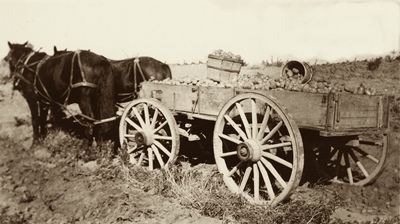
Wagons change a little through the years, so this photo from the 1930s may differ somewhat from John's wagons.
|
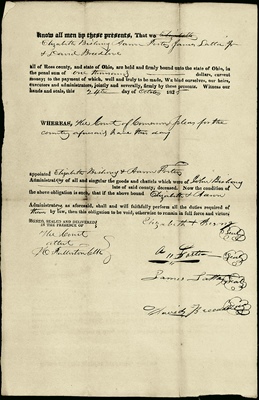
The Estate Bond for John Bushong deceased, written October 24, 1825.
|
|
The beginning of 1824, was marked by the sad loss of John's son. James Bushong had moved to Logan County, where he died shortly after signing his will on January 10 1824. His death was probably from gangrene, caused by the wound that would not heal on a leg, that was mentioned in his will.43 John and Elizabeth surely attended the funeral, where is not known, maybe he was buried in Franklin, with his mother. Following the death of his son, John continued working on the farm, trying to keep his new family fed and clothed. From later estate records, the repairs to his wagons were extensive and the shoeing of his horses was frequent. The wagons broke rims, running gears, and tackle. The roads were obviously incredibly rough or there were a lot of miles put on John's wagons, probably both. He used three different blacksmiths, as well as his son, George, for repairs, not to mention the farrier.12 But like his wagons, John was running down. On October 6, 1824, John and Elizabeth Bushong conveyed 121.2 acres in Ross County to George Bushong for $1.00.40 Since apparently John (Jr.) and James, before he died, never paid back John for the land he got for them from Duncan McArthur. So George's property was to even out what turned into gifts from John.40
But in 1825, as the year wore on, John was becoming ill. By September, he had inevitably been sick for weeks, if not longer, being attended by Doctors John Boyd and David Wills.12 The exact date is not known, but Dr. Wills visited, on September 11, 1825 and Elizabeth opened probate on October 24, 1825. So John's death was probably before October, and likely close to September 24, 1825 (30 days before probate). But lacking evidence, the closest to his date of death, we can say would seem to be, September 1825.
When John Bushong died, Elizabeth gave him a proper burial, and this is shown by the bills to his estate.12 John was buried in a coffin made by Joseph Shepherd ($9.50), wrapped with a burial shroud ($6.00) and after the grave diggers finished pailing in the grave ($2.43 and 3/4¢), it was marked with a proper gravestone ($15.00). They inevitably buried John in Franklin Township, but the place of interment has not been located. Though there is no proof, it is felt that his and Jenette's graves, did not survive the construction of the Ohio and Erie Canal. Perhaps even his mother's and son's graves, along with the entire cemetery disappeared too. The canal's construction progressed down the Scioto River, arriving at the Franklin Township in 1831. The changes for township culminated with the major project, of the so named, Three Locks and State Dam, which were completed in 1832.44 The cemetery could have been "moved" during construction. Then, as often happened, the bodies were all re-buried in a common grave with no markers, which is a sad ending for so many pioneers. Maybe a better understanding of their final resting spot will emerge someday.
From estate records, John appears to have died intestate and as such, his estate was liquidated. The administrators were Elizabeth Breedlove, Aaron Foster, James Latter Jr., and her son, David Breedlove. The Bushong heirs, obviously excluded, had either received their inheritance directly from their father, or were to get nothing. A sale was advertised in the Scioto Gazette, October 26, 1825 and according to the paper occurred November 11th. Elizabeth kept some items for herself, but most of it was just sold off. Listing just a few items: one square table - $1.75, seven "old" chairs - .64¢, one silver watch - $4.62 and 1/2¢, one smooth (bore) rifle-gun - $6.44, one powder horn and pick - .25¢, and so on.12 Bit by bit the pieces of John's and Jenette's lives were sold off. The administrators unfortunately did not note who bought which items, so it is not known, but it is possible, some of John and Jenette things stayed in the family. if the children could afford it.
|
Did John Squander Away the Farm?
or
The Missing Instrument of Defeasance?
|
After John's passing, as mentioned, there was a lawsuit. Read the entire complaint. In the suit, begun on April 17, 1826 and resolved in 1827, John Mitchel, representing his wife, Sally and the other heirs, felt that they had been cheated out of the family farm, by Elizabeth's son, Bayles Breedlove. In a deed dated October 8, 1824 John Bushong had sold/conveyed his farm to Bayles for $500. But Mr. Mitchel, contended that the farm was worth $3,500. He also represented that Bayles and his mother, pressured and scared John into conveying the farm to Bayles. It was supposed to protect it from being taken in a potential lawsuit, for money owed on land purchased from Duncan McArthur. John had purchased the properties for his sons, James and John (Jr.), and as seen, he had notes from them in the amount of $160 (if his wallet had been returned in 1820). Mr Mitchel alleged that Bayles and his mother, had frightened John into conveying a valuable property, over a trifling $160 debt. Interestingly, Mr. Mitchel's suit relates a conversation between his father in-law and his heirs, who wondered if conveying the farm over such a small debt was not a rash step.
John replied...
"Baylies would never (cheat) them out of a cent, that it was relieving him of trouble and (when) that security debt was paid, that he (John) had taken an instrument of defeasance from Baylies to allow (him to) reconvey the farm to him or his heirs or pay him or them the full value thereof as he or they might elect so soon as said security debt was settled."23
He had an "instrument of defeasance or in other words, a paper voiding the conveyance. John knew his farm was worth more than $500, so he made a contract, that Bayles obviously had signed, to void the sale. Just to contrast land values, some 20 years earlier, the 98' x 198' lot, admittedly in the city, sold for $300. However, though it can not be said what a real value for John's farm was, it certainly was more than what Bayles gave him. Further, the debt to General McArthur does not appear in the estate, as such, it may have been settled in advance. Even though there was money in the estate, to pay back Bayles, the farm is not noted in the records, and apparently, Bayles kept it. So having properly conveyed the property, and with no sign of John's stated "instrument of defeasance", Mr. Mitchel's case was not proven. Where did that document go? Would John have kept it in his wallet along with his other papers? It can not be known, but it surely disappeared. John Mitchel had no case and actually ended up paying ($39.84) for Bayles' legal costs. But the irony does not go unnoticed, that what appears to be an under-priced sale, is in a sense, losing the farm, and it was seemingly caused by sons James' and John (Jr's) failure to repay John for their properties. That was the reason John made the deal with Bayles, and in the end, it cost him, the farm and his heirs part of their inheritance. As a final note, the law suit obviously did little to improve Mr. Mitchel and Bayles' relationship, because not too long after, Mr. Mitchel sued Bayles for slander. This time he won and Bayles was ordered to pay $1,000.23
|
|
General Duncan McArthur. With all his and John's dealings, would he really have taken John's farm?
|
As discussed, John Mitchel was an eye witness and privy to much of the last 10 years of John Bushong's life. As such his descriptions of John should be of great interest to John's heirs. Yet in the sworn affidavit, Mitchel calls or describes his father in-law as an old man. In fact he used the word "old" six time to describe John.23 And that was describing John at the time of his marriage to Elizabeth, at age 62, too. But John's father, Andrew, at age 63 was traveling the Wilderness Trail, with his family and belongings, obviously still retaining vitality.45 And Andrew, lived some nine years afterwards, too. Further, two of John's children, are known to have lived much longer, too, age 88 and 93.2 So John did die earlier than most. Perhaps his long trips and inevitably wild adventures up and down the rivers, took their toll on him? Further, Mr. Mitchel, describes John as not at his full mental capacity and somewhat befuddled in his old age.
Mitchel said "John being old and infirm was pirated and drawn into intimacy with one Elizabeth Breedlove." and that "John Bushong was never considered a man of Great talents, but an honest frugal man and for many years one among the most respectable citizens of Ross County..." Yet "the old man's mind in addition to its natural tendency, being at the time very much enfeebled by age and sickness and (he was) affrighted at a suit."23 |
Mr. Mitchel, does not paint his father in-law in the best light, and these statements, could not have been well received by John's other children and heirs. Regardless of the fact, that Mr. Mitchel was trying to make his case, there is inevitably a measure of the truth in his descriptions, since they were in a sworn affidavit. So it can not be helped but to conclude, that by the time John remarried, he was pretty well worn-out and was aging rapidly. He was still banging over bad roads in wagons with hard wooden seats and no suspension and along with his wagons, wearing himself out. John also smoked and drank (and likely cussed), since probably before his days on the river.12 So at 62, he really had become an old man, and certainly was not as sharp as he might have been. Did the Widow Breedlove, conspire to "catch" John when he became a widower? Surely. Elizabeth was a widow in need and her family was very important to her. She needed a husband and John Bushong fit the bill. We can be certain that John's heirs were not thrilled with the loss of their father's time, attention, and spending money to his "new family." However, as far as we can tell, John opened his heart to his new family just like he opened his home, and after all, it is what he wanted.
|

An early (1867) Ohio State Seal.
|
|
And so it goes, an immigrant's son, grandson and great grandson, John Bushong, the pioneer, frontiersman, Indian fighter, freighter, riverman and farmer, just wore out in the end. Able to work less and less, with his new family needing more, he might have felt burdened by his growing debt. But his estate netted over $1,400, and he need not have worried.12 Also, it should be recalled, though his children did not inherit the farm, each son had been given land. Regardless, John died inevitably surrounded by his new family, and was buried in a cemetery that has faded away, like his possessions, like the farm, and ultimately like he did. Nevertheless, aside from his children, John's decision to migrate into the Northwest Territory could arguably be his greatest contribution. In doing so he had removed his family from the environment of slavery in Kentucky, which eventually drew in his brothers, Henry and for a while, Jacob. Through John's curiosity and determination he and his family became the first Bushongs ever in Ohio, as well as, members of the prestigious First Families of Ohio. And because of him, half the rest of the family, with his mother, Catherine, brothers, Valentine, and later Jacob with his own family, came too. And fittingly, all of them, excepting Valentine, who is not known, raised their families north of the extended Mason-Dixon line. Eventually, when the other Bushongs made their way into Ohio, it would become home to the greatest number of Bushong Families anywhere in America. In Ohio, like their ancestors, they capitalized on the opportunities their new country and its fledgling American democracy presented. From there, they thrived and John's and Jenette's descendants grew into another proud branch in the Bushong Family Tree.
|
|
John Bushong's autograph, February 19, 1824, from his estate records. |
This Article is Copyright ©2015, ©2018, by Rick Bushong and Commercial Use is Prohibited.
Non-commercial use is permitted if copyright information is included.
|
Bushong United is Copyright ©2018-2023 by Rick
Bushong any Commercial Use is Prohibited.
Non-commercial use is allowed with permission or if
copyright is included.
Photographs, unless otherwise noted, are in the commons, and are free use. No bandwidth theft allowed.
To Direct Search the Bushong United Family Tree
click here
|


